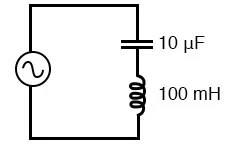 Simple series resonant circuit.
Simple series resonant circuit equation
Simple series resonant circuit.
Simple series resonant circuit equation
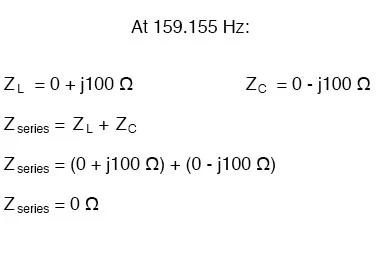 With the total series impedance equal to 0 Ω at the resonant frequency of
159.155 Hz, the result is a short circuit across the AC power source at
resonance. In the circuit drawn above, this would not be good.
I’ll add a small resistor (Figure below) in series with the capacitor and
the inductor to keep the maximum circuit current somewhat limited, and
perform another SPICE analysis over the same range of frequencies.
With the total series impedance equal to 0 Ω at the resonant frequency of
159.155 Hz, the result is a short circuit across the AC power source at
resonance. In the circuit drawn above, this would not be good.
I’ll add a small resistor (Figure below) in series with the capacitor and
the inductor to keep the maximum circuit current somewhat limited, and
perform another SPICE analysis over the same range of frequencies.
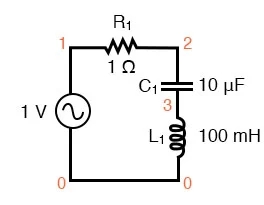 Series resonant circuit suitable for SPICE.
series lc circuit
v1 1 0 ac 1 sin
r1 1 2 1
c1 2 3 10u
l1 3 0 100m
.ac lin 20 100 200
.plot ac i(v1)
.end
Series resonant circuit suitable for SPICE.
series lc circuit
v1 1 0 ac 1 sin
r1 1 2 1
c1 2 3 10u
l1 3 0 100m
.ac lin 20 100 200
.plot ac i(v1)
.end
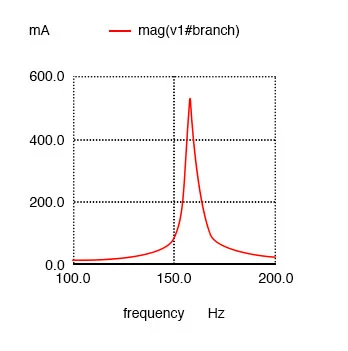 Series resonant circuit plot of current I(v1).
As before, circuit current amplitude increases from bottom to top, while
frequency increases from left to right. The peak is still seen to be at the
plotted frequency point of 157.9 Hz, the closest analyzed point to our
predicted resonance point of 159.155 Hz.
This would suggest that our resonant frequency formula holds as true for
simple series LC circuits as it does for simple parallel LC circuits, which
is the case:
Series resonant circuit plot of current I(v1).
As before, circuit current amplitude increases from bottom to top, while
frequency increases from left to right. The peak is still seen to be at the
plotted frequency point of 157.9 Hz, the closest analyzed point to our
predicted resonance point of 159.155 Hz.
This would suggest that our resonant frequency formula holds as true for
simple series LC circuits as it does for simple parallel LC circuits, which
is the case:
 resonant frequency formula
A word of caution is in order with series LC resonant circuits: because of
the high currents which may be present in a series LC circuit at resonance,
it is possible to produce dangerously high voltage drops across the
capacitor and the inductor, as each component possesses significant
impedance.
We can edit the SPICE netlist in the above example to include a plot of
voltage across the capacitor and inductor to demonstrate what happens.
series lc circuit
v1 1 0 ac 1 sin
r1 1 2 1
c1 2 3 10u
l1 3 0 100m
.ac lin 20 100 200
.plot ac i(v1) v(2,3) v(3)
.end
resonant frequency formula
A word of caution is in order with series LC resonant circuits: because of
the high currents which may be present in a series LC circuit at resonance,
it is possible to produce dangerously high voltage drops across the
capacitor and the inductor, as each component possesses significant
impedance.
We can edit the SPICE netlist in the above example to include a plot of
voltage across the capacitor and inductor to demonstrate what happens.
series lc circuit
v1 1 0 ac 1 sin
r1 1 2 1
c1 2 3 10u
l1 3 0 100m
.ac lin 20 100 200
.plot ac i(v1) v(2,3) v(3)
.end
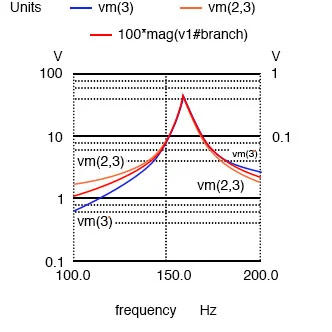 Plot of Vc=V(2,3) 70 V peak, VL=v(3) 70 V peak, I=I(V1#branch) 0.532 A
peak
According to SPICE, the voltage across the capacitor and inductor reaches a
peak somewhere around 70 volts!
This is quite impressive for a power supply that only generates 1 volt.
Needless to say, caution is in order when experimenting with circuits such
as this. The SPICE voltage is lower than the expected value due to the small
(20) number of steps in the AC analysis statement (.ac lin 20 100 200).
What is the expected value?
Given: fr = 159.155 Hz, L = 100mH, R = 1
XL = 2πfL = 2π(159.155)(100mH)=j100Ω
XC = 1/(2πfC) = 1/(2π(159.155)(10µF)) = -j100Ω
Z = 1 +j100 -j100 = 1 Ω
I = V/Z = (1 V)/(1 Ω) = 1 A
VL = IZ = (1 A)(j100) = j100 V
VC = IZ = (1 A)(-j100) = -j100 V
VR = IR = (1 A)(1)= 1 V
Vtotal = VL + VC + VR
Vtotal = j100 -j100 +1 = 1 V
The expected values for capacitor and inductor voltage are 100 V. This voltage
will stress these components to that level and they must be rated accordingly.
However, these voltages are out of phase and cancel, yielding a total voltage
across all three components of only 1 V, the applied voltage. The ratio of the
capacitor (or inductor) voltage to the applied voltage is the “Q” factor.
Q = VL/VR = VC/VR
Plot of Vc=V(2,3) 70 V peak, VL=v(3) 70 V peak, I=I(V1#branch) 0.532 A
peak
According to SPICE, the voltage across the capacitor and inductor reaches a
peak somewhere around 70 volts!
This is quite impressive for a power supply that only generates 1 volt.
Needless to say, caution is in order when experimenting with circuits such
as this. The SPICE voltage is lower than the expected value due to the small
(20) number of steps in the AC analysis statement (.ac lin 20 100 200).
What is the expected value?
Given: fr = 159.155 Hz, L = 100mH, R = 1
XL = 2πfL = 2π(159.155)(100mH)=j100Ω
XC = 1/(2πfC) = 1/(2π(159.155)(10µF)) = -j100Ω
Z = 1 +j100 -j100 = 1 Ω
I = V/Z = (1 V)/(1 Ω) = 1 A
VL = IZ = (1 A)(j100) = j100 V
VC = IZ = (1 A)(-j100) = -j100 V
VR = IR = (1 A)(1)= 1 V
Vtotal = VL + VC + VR
Vtotal = j100 -j100 +1 = 1 V
The expected values for capacitor and inductor voltage are 100 V. This voltage
will stress these components to that level and they must be rated accordingly.
However, these voltages are out of phase and cancel, yielding a total voltage
across all three components of only 1 V, the applied voltage. The ratio of the
capacitor (or inductor) voltage to the applied voltage is the “Q” factor.
Q = VL/VR = VC/VR
REVIEW: